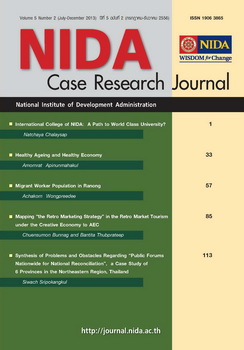Mapping “the Retro Marketing Strategy” in the Retro Market Tourism under the Creative Economy to AEC
Keywords:
Creative Economy, Retro Marketing Strategy, Retro Market Tourism, Nostalgia and LifestylesAbstract
The Creative Economy was announced to be a national policy in the Thai National Economics and Social Development Plan issue no. 11 (2012-2016) to drive Thai economic mechanism called “Creative Thailand project”. Until now, Thailand has been implementing the creative economy, which takes in competitiveness of business sectors i.e. creative entrepreneurs, small businesses and communities to generate the creative thinking and to differentiate products and services in creativity. The “Creative Economy” and “Creativity” have played an important role in business sectors, especially in the tourism industry. Tourism industry has been strategized to be one of the f ifteen f lagship industrial groups to enhance the competitiveness potential in generating jobs, distributing income and promoting investment. It has been integrated with the root of distinguished cultures in each community, as well as the innovation technology to enhance their products and services. Accordingly, the rate of Thai tourists in the past three years has risen in terms of travelling in the Retro Market tourism, such as ancient markets and f loating markets, and the average rate is continuously growing by 30-40 percent per year. Retro Market tourism has become trendy itinerary for Thais and foreign tourists from both European and AEC countries.This case study conveys a brief review of two Retro Market tourism sites under the creative economy. They are Ampawa f loating market in Samutsongkram province and Plern Wan market in Prachub Khirikhan province. The analysis of how both markets get successful in applying two types of “the Retro Marketing Strategies” to their creativity to attract tourists is illustrated in the case. The f irst strategy is called “Retro Retro” in which the Ampawa market employs nostalgic feelings to associate with the past. The nostalgia as a term referring to the “good old days” from one’s earlier life describes a sentimentality for the past, typically for a period or places with content personal associations which can be applied to present products, places and services. On the other hand, the second strategy is called “Retro Nova” in which the Plern Wan market utilizes to create a replica of an authentic market that stimulates new consumer experiences and perceptions. The case points out a signif icant challenge and leaves a question for further research, however. To achieve Creative Thailand, what core values have to associate with consumers’ experiences and their lifestyles to get interesting in the Retro Market tourism? Furthermore, 7Ps in the marketing mix and SWOT analysis of both markets show how their factors affect the decision making of Thai tourists in the Retro Market tourism.
How to Cite
Bunnag, C., & Thubprateep, B. (2014). Mapping “the Retro Marketing Strategy” in the Retro Market Tourism under the Creative Economy to AEC. NIDA Case Research Journal, 5(2), 82–112. retrieved from https://so04.tci-thaijo.org/index.php/NCRJ/article/view/27664
Issue
Section
Case Study





